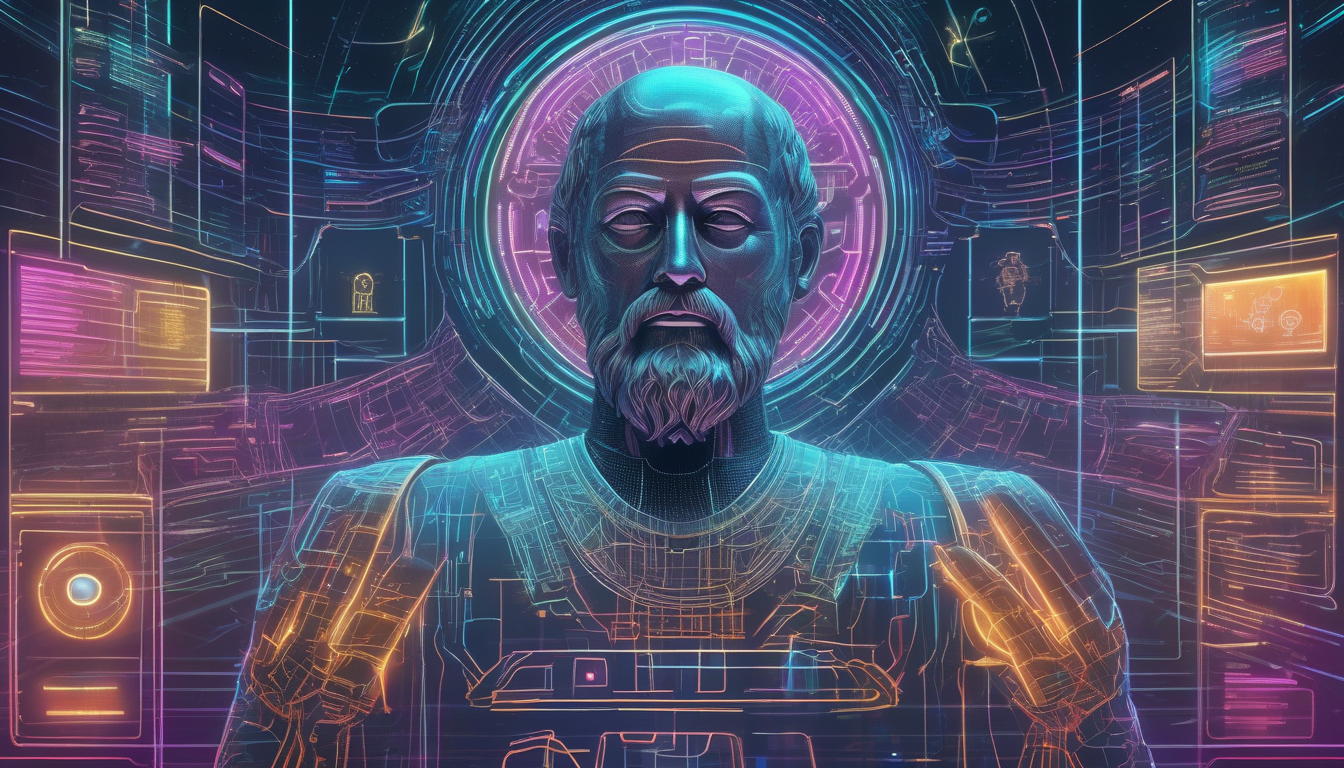The journey of dialogue stretches back to ancient Greece, where the great philosopher Socrates pioneered a method of questioning that transformed the way we communicate. His approach wasn’t just about exchanging words; it was about diving deep into the essence of thoughts and ideas. Imagine sitting in a sunlit courtyard, engaged in a lively discussion, where every question leads to another layer of understanding. This is the beauty of dialogue—a dance of intellect and emotion that has evolved over centuries.
Fast forward to today, and we find ourselves in a world where dialogue has taken on new forms, thanks to technology. The essence of conversation remains, but the platforms have changed dramatically. From face-to-face interactions to text messages, and now to AI-driven conversations, the art of dialogue is constantly being redefined. It’s like watching a river flow; it may change its course, but the water still carries the same life-giving essence.
In this digital age, communication has become more accessible, allowing voices from every corner of the globe to join the conversation. However, this also presents challenges. How do we ensure that our dialogue remains meaningful amidst the noise? How do we foster genuine connections in a sea of information? These questions are crucial as we navigate the complexities of modern communication.
As we explore the intersection of artificial intelligence and human interaction, we must consider the implications of machines engaging in dialogue. AI systems are being designed to mimic human conversation, but can they truly understand the nuances of emotion and intent? This brings us to the ethical dimensions of dialogue. It’s not just about what is said, but how it is said. The responsibility lies with creators to foster respectful and constructive communication, ensuring that the essence of dialogue is preserved.
Looking ahead, the future of dialogue is ripe with possibilities. Emerging technologies promise to further reshape how we connect and converse. Will we see more immersive experiences that bridge the gap between digital and physical interactions? Only time will tell, but one thing is clear: the art of dialogue will continue to evolve, reflecting our ever-changing society.

The Philosophical Roots of Dialogue
When we think about dialogue, it’s hard not to trace its roots back to the great philosopher Socrates. His method of questioning, known as the Socratic Method, revolutionized how we engage in discussions. Imagine sitting in a bustling Athenian marketplace, where ideas clash and converge. Socrates would ask probing questions, encouraging his interlocutors to think deeply and critically about their beliefs. This approach didn’t just aim to win an argument; it sought to uncover truth through rigorous inquiry.
At the heart of Socratic dialogue lies the art of questioning. This isn’t just about asking any question; it’s about asking the right questions. Socrates believed that through careful questioning, one could peel back layers of ignorance and reach a deeper understanding of complex issues. Today, this method remains relevant, reminding us that effective dialogue is not merely about speaking but also about listening and reflecting. It’s a dance of ideas, where each participant contributes to a greater understanding.
Moreover, the significance of critical thinking in dialogue cannot be overstated. In ancient times, engaging in dialogue meant challenging the status quo and questioning societal norms. This tradition continues today, as we navigate conversations about ethics, politics, and personal beliefs. The ability to analyze and evaluate arguments is essential in fostering meaningful discussions. Without critical thinking, dialogue can easily devolve into mere rhetoric, losing its potential for genuine understanding.
In essence, the philosophical roots of dialogue remind us that communication is more than exchanging words; it’s about fostering a culture of understanding and respect. As we engage in conversations, whether in person or through digital platforms, we must remember the lessons of the past. Just like Socrates, we should strive to ask questions that lead to enlightenment rather than division.

The Role of Rhetoric in Communication
Rhetoric, the art of persuasion, has been a cornerstone of effective communication since the days of ancient Greece. Imagine standing in a crowded marketplace, trying to convince a group of people to buy your wares. How do you capture their attention? How do you make them feel compelled to listen? That’s where rhetoric comes into play. It’s not just about what you say; it’s about how you say it. The *power of words* can ignite passion, inspire action, and even change minds.
Throughout history, rhetoric has shaped societal norms and influenced the course of events. Think about the great speeches that have moved nations or the written works that have sparked revolutions. From Aristotle’s teachings to modern-day political debates, the principles of rhetoric remain relevant. It’s fascinating to see how these techniques have evolved yet retained their core essence. Rhetoric can be broken down into several key components:
- Ethos: Establishing credibility and trustworthiness.
- Pathos: Appealing to the audience’s emotions.
- Logos: Using logic and reason to persuade.
These elements work together like a well-tuned orchestra, creating a symphony of communication that resonates with audiences. For instance, a politician might use ethos by sharing their personal story to build rapport. Simultaneously, they might invoke pathos by discussing the struggles of everyday citizens, appealing to the audience’s feelings. Finally, they back it up with logos by presenting facts and statistics, making their argument compelling and hard to refute.
In today’s world, where communication happens at lightning speed, understanding the role of rhetoric is more important than ever. With social media platforms amplifying voices, the ability to persuade has shifted from the hands of a few to the many. However, this democratization comes with challenges. Misinformation can spread just as quickly as genuine discourse, making it crucial for individuals to be discerning consumers of rhetoric.
In conclusion, rhetoric is not just a tool; it’s an essential part of how we connect and communicate with one another. By mastering the art of rhetoric, we can enhance our conversations, influence opinions, and ultimately foster a more informed society.

Dialogue in the Digital Age
In today’s fast-paced world, dialogue has transformed dramatically due to the rise of digital technology. Gone are the days when conversations were limited to face-to-face interactions or even phone calls. Now, we find ourselves immersed in a digital landscape where communication is just a click away. But what does this mean for the way we connect with one another?
Digital platforms have revolutionized how we engage in dialogue. Social media, forums, and instant messaging apps have created a global stage for discussions, allowing voices from all corners of the world to be heard. This vast reach can be both a blessing and a curse. On one hand, it fosters diversity of thought and encourages the exchange of ideas; on the other, it can lead to misunderstandings and conflicts due to the absence of non-verbal cues that are crucial in face-to-face communication.
Consider the impact of emojis and GIFs in our conversations. These digital symbols add a layer of emotion and context that text alone often lacks. They serve as modern-day hieroglyphics, helping to convey feelings and intentions that might otherwise be lost. However, this reliance on visual shorthand can sometimes dilute the depth of our discussions, leading to misinterpretations.
Moreover, the rise of artificial intelligence has introduced new dynamics to dialogue. AI chatbots and virtual assistants are now part of our everyday interactions, providing instant responses and information. While they enhance efficiency, they also raise questions about the quality of communication. Are we sacrificing genuine human connection for convenience? As we navigate this digital age, it’s essential to reflect on the nature of our interactions.
To illustrate the shift in dialogue, consider the following table that compares traditional conversation methods with modern digital communication:
| Aspect | Traditional Dialogue | Digital Dialogue |
|---|---|---|
| Medium | Face-to-Face | Text, Voice, Video |
| Speed | Measured | Instantaneous |
| Emotional Cues | Non-Verbal | Emojis, GIFs |
| Accessibility | Limited | Global |
As we continue to embrace these digital tools, it’s crucial to remain mindful of how they shape our dialogue. Are we truly connecting, or are we merely exchanging words? The challenge lies in finding a balance that allows us to harness the benefits of technology while preserving the essence of meaningful conversation.

AI and Human Interaction
In today’s rapidly evolving digital landscape, the intersection of artificial intelligence and human interaction is nothing short of fascinating. Imagine having a conversation with a machine that not only understands your words but also grasps the nuances of your emotions. This is no longer the stuff of science fiction; it’s becoming our reality! AI systems, like chatbots and virtual assistants, are designed to engage in dialogue with us, often mimicking human conversational patterns. But what does this mean for the way we communicate?
At the heart of AI’s ability to interact lies natural language processing (NLP), a technology that allows machines to understand and respond to human language in a way that feels intuitive. This capability opens up a world of possibilities, from enhancing customer service experiences to facilitating more personalized interactions in various sectors. However, it also raises some important questions: Are we losing the essence of human connection? Could we become overly reliant on machines for communication?
Consider the following aspects of AI and human interaction:
- Accessibility: AI can democratize communication, allowing individuals with disabilities to engage more fully in conversations through voice recognition and text-to-speech technologies.
- Efficiency: In fast-paced environments, AI can handle routine inquiries, freeing humans to focus on more complex issues that require emotional intelligence and creativity.
- Learning Opportunities: AI systems can analyze vast amounts of data to identify trends in dialogue, offering insights that can enhance our understanding of effective communication.
Yet, while AI can facilitate connections, it cannot replace the depth of human interaction. The emotional subtleties and shared experiences that come from face-to-face conversations are irreplaceable. As we embrace these technological advancements, it’s crucial to maintain a balance. We must ensure that our interactions with AI enhance, rather than hinder, our ability to connect with one another on a deeper level.
In conclusion, the relationship between AI and human interaction is a double-edged sword. While it offers exciting advancements in communication, it also challenges us to reflect on what it means to truly connect. As we navigate this new frontier, let’s strive to harness the power of AI while cherishing the irreplaceable human elements of dialogue.

The Ethics of Dialogue
In an era where communication is increasingly mediated by technology, the ethics of dialogue have never been more critical. Engaging in conversations—whether face-to-face or through digital platforms—requires a set of moral guidelines that ensure respect, understanding, and constructive exchange. But what does it mean to engage ethically in dialogue? It’s not just about saying the right things; it’s about fostering an environment where all voices can be heard and valued.
One of the primary ethical considerations is respect for diverse perspectives. In any dialogue, especially in multicultural settings, acknowledging and appreciating differing viewpoints is essential. This means being open to listening, rather than just waiting for your turn to speak. Think of dialogue as a dance: if one partner is always leading without listening, the rhythm is lost. Ethical dialogue invites all participants to share the floor.
Moreover, the rise of artificial intelligence in communication introduces new ethical dilemmas. AI systems, while capable of processing vast amounts of information, often lack the emotional intelligence that human interactions thrive on. This raises questions about the responsibility of creators to design AI that promotes respectful dialogue. For instance, how can we ensure that AI respects cultural nuances and avoids perpetuating biases? Here, the creators must tread carefully, considering the potential impact of their algorithms on real-world conversations.
Additionally, the concept of transparency plays a crucial role in ethical dialogue. Participants should be aware of the context and intent behind conversations, especially in digital spaces where anonymity can breed hostility. When engaging online, it’s vital to communicate openly about one’s motives, whether they are to inform, persuade, or entertain. This transparency fosters trust, which is the bedrock of any meaningful dialogue.
In conclusion, the ethics of dialogue are not merely abstract principles; they are practical guidelines that shape our interactions. As we navigate the complexities of modern communication, let’s strive to create dialogues that are not only informative but also respectful and constructive. By doing so, we can ensure that our conversations—whether human or AI-driven—are enriching and beneficial for everyone involved.

Future Trends in Dialogue
As we peer into the crystal ball of communication, it’s clear that the future of dialogue is poised for transformation. With the rapid advancement of technology, the way we converse is changing at an unprecedented pace. Imagine a world where conversations are not just limited to humans, but where artificial intelligence plays a pivotal role in shaping our discussions. This isn’t science fiction; it’s happening now!
One of the most exciting trends is the rise of multimodal communication. Gone are the days when dialogue was confined to text or voice alone. In the future, we can expect to engage in conversations that seamlessly blend text, voice, video, and even virtual reality. This shift will enable richer, more immersive interactions, allowing us to communicate in ways that feel more natural and engaging.
Furthermore, as AI technology continues to evolve, we will see more sophisticated systems capable of understanding context, emotions, and nuances in conversation. This means that AI could not only respond to our queries but also engage in meaningful discussions, providing insights that were once the realm of human intellect. However, this raises a critical question: how do we ensure that these AI systems communicate ethically and responsibly?
Another trend to watch is the rise of personalized communication. In a world flooded with information, individuals are seeking tailored experiences. Future dialogue platforms may leverage data analytics to create personalized interactions, adapting to users’ preferences and communication styles. Imagine a digital assistant that knows your likes and dislikes, adjusting its conversational tone and content accordingly!
Moreover, as globalization continues to shrink our world, the need for cross-cultural dialogue will become increasingly important. Future technologies will likely facilitate conversations that bridge cultural gaps, fostering understanding and collaboration among diverse groups. This could be achieved through advanced translation tools that not only convert languages but also capture cultural nuances.
In conclusion, the future of dialogue is bright and full of potential. As we embrace these trends, we must remain vigilant about the ethical implications and strive for communication that is not only effective but also respectful and inclusive. The art of conversation is evolving, and it’s up to us to shape it into a force for good.

Conclusion: The Evolving Nature of Dialogue
As we journey through the rich tapestry of dialogue, it’s clear that communication is not just a tool; it’s the very fabric that weaves our societies together. From the ancient streets of Athens where Socrates posed his thought-provoking questions to the bustling digital platforms of today, dialogue has continuously evolved, adapting to the changing landscapes of human interaction. Isn’t it fascinating how a simple conversation can shape our understanding and perceptions?
In this age of rapid technological advancement, we find ourselves at a crossroads. The emergence of artificial intelligence has introduced a new dimension to dialogue, one that challenges traditional notions of communication. While AI can mimic human conversation, it raises important questions about authenticity and emotional connection. Are we ready to embrace these new forms of dialogue, or do we risk losing the essence of what makes communication meaningful?
Moreover, the ethical implications surrounding dialogue, particularly in the realm of AI, cannot be overlooked. As creators and users of these technologies, we bear a responsibility to foster respectful and constructive conversations. This means being mindful of the language we use and the impact it has on our interactions. After all, dialogue is not just about exchanging words; it’s about building bridges of understanding and connection.
Looking ahead, the future of dialogue promises to be even more dynamic. With emerging technologies like virtual reality and augmented reality, the way we engage in conversation could be transformed in ways we can only imagine. As we embrace these innovations, we must remain committed to the core values of dialogue: empathy, respect, and openness.
In summary, the evolution of dialogue is a testament to our innate desire to connect and understand each other. Whether through philosophical discourse, persuasive rhetoric, or digital interactions, the significance of dialogue remains unwavering. It is through these conversations that we learn, grow, and ultimately, find common ground. So, let’s continue to explore the art of dialogue, ensuring it remains a vital part of our human experience.
Frequently Asked Questions
- What is the significance of dialogue in shaping knowledge?
Dialogue has always been a vital tool for exchanging ideas and fostering understanding. It allows individuals to explore different perspectives, challenge assumptions, and ultimately, build a shared knowledge base. Just like a bridge connects two shores, dialogue connects minds!
- How did Socratic methods influence modern communication?
Socratic methods emphasize questioning and critical thinking, which are essential for meaningful discussions. By encouraging individuals to ask ‘why’ and ‘how,’ these methods promote deeper understanding and insight, paving the way for richer conversations today.
- How has technology transformed dialogue in recent years?
With the rise of digital platforms, dialogue has become more accessible and global. People can now engage in conversations across continents, breaking down barriers. However, this also brings challenges, like miscommunication and the spread of misinformation, akin to a double-edged sword.
- What role does AI play in modern dialogue?
AI systems are designed to interact with humans in a conversational manner, mimicking human dialogue. While this can enhance communication, it raises questions about authenticity and emotional connection, reminding us that not all conversations are created equal!
- What ethical considerations should be taken into account in AI interactions?
It’s crucial for creators to ensure that AI dialogues are respectful and constructive. This means programming AI to avoid harmful language and promote positive engagement, much like teaching a child the importance of kindness in conversations.
- What does the future hold for dialogue?
As technologies continue to evolve, we can expect dialogue to transform even further. Emerging tools may redefine how we communicate, opening new avenues for connection and understanding, like a constantly unfolding story waiting to be told!


